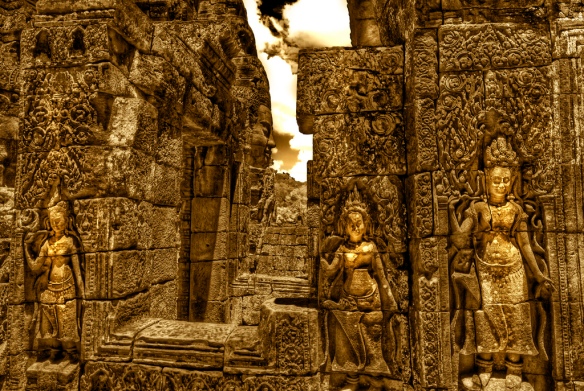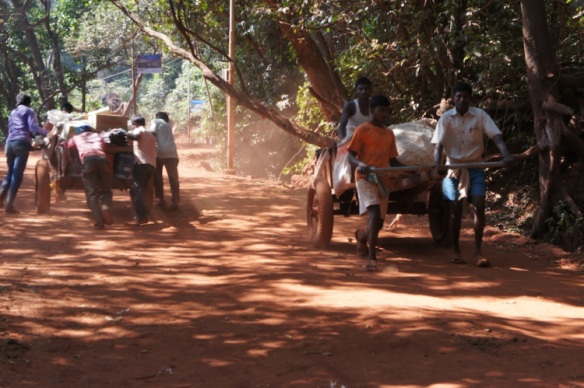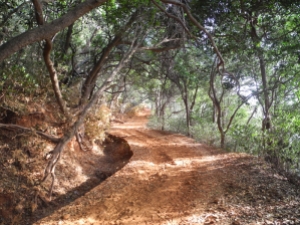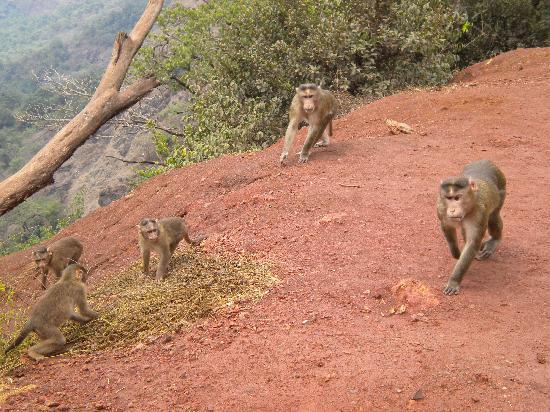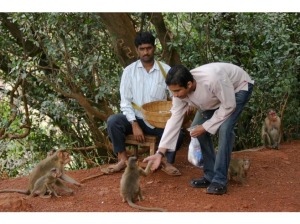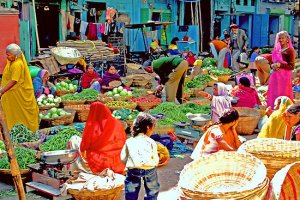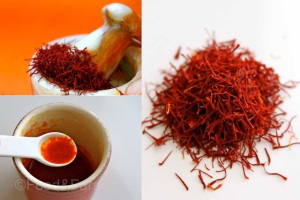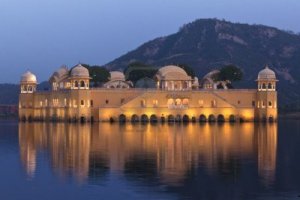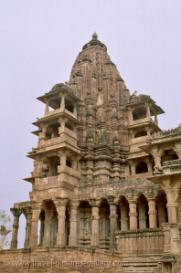I lost my heart to India many years ago. At the end of 1990, I spent about a month touring that magnificent country with some dear friends. India captivated my mind, overwhelmed my senses, and held me hostage. She brought me feelings of serenity, joy, amazement, and peace — a sense of having come “home” which was quite strange for someone utterly new to the country and who had lived the life of a wandering nomad. India was, quite simply, the most intoxicating, fascinating place I’d ever seen in my long list of travels. I fell in love and have never stopped. Among the many places in that gloriously dazzling country that stand out in my mind is Matheran. It is a hill station on the Western Ghat mountain range and a few hours outside of Mumbai. Every part of Matheran — and my trip up it — is etched indelibly in my mind. After a long drive, we arrived at the base of a giant mountain.
Before us lay a vast, curling, climbing road covered in bright, terracotta-red dust. An endless phalanx of dark, leafy trees on either side provided shade and a green canopy above our heads through which peeked a bright blue sky. The trees were gnarled and twisted, their enormous, beige roots visible and clawing at what little remained of the dusty earth surrounding them, a victim of the battering monsoons. Everywhere, small taupe monkeys scampered around, chattering and talking a mile a minute as they ran ahead of us or leaped up on the trees.
You can’t drive up Matheran as it is one of the few places in the world where cars are completely forbidden, so you take donkeys or horses. Gingerly, you place yourself on their bony bodies as you slowly ride that long, winding, red trail up, up and up.
Eventually, you get to the very top to behold a canyon that seems as vast as America’s Grand Canyon — only this one is a sea of green trees and golden earth that stretches out as far as the eye can see. My friend had a large summer place at the very top, overlooking the canyon, and the sight at dawn and dusk rendered me utterly speechless. Words simply cannot convey any of it. Not even for one as verbose as myself.
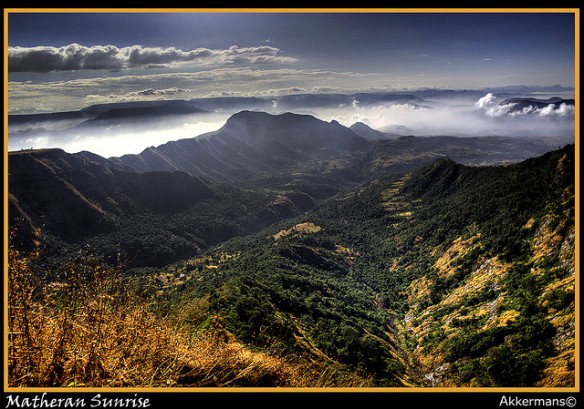
Matheran. Used with permission from the talented photographer: Peter Akkermans. Site: http://www.fotoakkermans.nl/
Matheran is what flashed before my eyes when I first smelled Trayee (pronounced as “Try-ee’), a brilliant, complex, rich perfume from the Parisienne Indie line, Neela Vermeire Créations, Parfums Paris (“NVC”). The niche perfume house was founded in 2011 by Neela Vermeire, a lawyer born in India and educated in the UK who now lives in Paris and is a self-taught nose of enormous talent. She collaborated with the famous perfumer, Bertrand Duchaufour, to launched three perfumes paying homage to different phases in India’s history and each has garnered enormous praise. (They sent perfumistas chattering like those monkeys on Matheran!) One of them, Bombay Bling, was chosen by the prestigious perfume website, CaFleureBon, as one of their top 25 fragrances for 2011. The greatest recognition, however, came for Trayee with what would be the equivalent of a perfume Oscar when the Fragrance Foundation recognized its creative excellence and nominated it for a Fifi award in the Indie category. 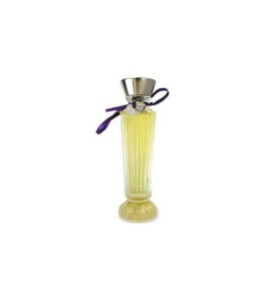
The vibrant kaleidoscope that is India is at the very heart of Trayee — and it is amply demonstrated by the perfume’s long list of notes:
Madagascar blue ginger, elemi, cinnamon, ganja accord, blackcurrant absolute, basil, Sambac jasmine absolute, Egyptian jasmine absolute, cardamom absolute, clove, saffron, Javanese vetiver, Haitian vetiver, incense, Mysore sandalwood oil, patchouli, myrrh, vanilla, cedar, amber notes, oudh palao from Laos, and oak moss.
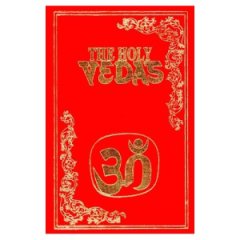 The complex notes are quite intentional because Trayee is a concrete evocation of India’s Vedic period (1500 BC to 500 BC), a time of great antiquity shrouded in mystery but known to be the source for what eventually became modern Hinduism. As Luckyscent (Trayee’s exclusive U.S. distributor) explains, the perfume’s name is:
The complex notes are quite intentional because Trayee is a concrete evocation of India’s Vedic period (1500 BC to 500 BC), a time of great antiquity shrouded in mystery but known to be the source for what eventually became modern Hinduism. As Luckyscent (Trayee’s exclusive U.S. distributor) explains, the perfume’s name is:
an allusion to the sacred origin of the first three Vedas, the most ancient sacred texts in India. The notes are drawn from the ingredients used in religious rituals and Ayurvedic medicine during the Vedic era. Rich in incense, myrrh and oud, the fragrance is a poignant blend of smoke, spices and resins that harks back to the very origins of perfumery – a burnt offering to the gods and an aid to meditation.
Trayee opens with a rich, potent burst of saffron, cardamom and oud. The oud was, as is often the case with agarwood, entwined with strong notes of rose. It was never synthetic or screechy, but true to the faintly medicinal, camphorous, chilly aspects of real agarwood. The combination of beautiful sweet saffron with the faintly nutty, aromatic sweetness of the cardamom provide a perfect counterbalance. Following on the heels of those notes is incense whose peppery, smoky accords provide a bit of a bite to the richness of the other ingredients.
That opening was the only consistent element in the two times that I tried Trayee. It is a perfume that is so magnificently blended that different elements peek out at different times, undulating like perfumed waves of richness, woodiness and spice. There is so much depth to Trayee that trying to pick out consistent notes is a bit of a hard task. In an interview with Bois de Jasmin, Ms. Vermeire summed up in one sentence much of my experience: “Trayee’s notes appear and reappear, keeping the wearer guessing and creating a memorable olfactory experience.” It is absolutely true. Equally true is Ms. Vermeire’s comment that:
Trayee is one of the most evocative fragrances for me. It is a rich woody composition, with sandalwood, oud, vetiver and incense lending it many facets. On me, it changes all the time.
The very first time I wore Trayee, the opening was followed by hints of cassis (which is how I’ve always known “black currant”), cloves, and ginger. There was smoke that stemmed from either the incense, the myrrh, elemi, or the cedar, along with some woody elements, black pepper and sweetness. As always with Trayee, it’s hard to know what scents stem from what ingredients but it always evokes the rich kaleidoscope of India.
All the notes were subsumed under the veil of saffron which is one of my favorite spices. There is a lovely floral nuttiness to the saffron due to the cardamom, and the combination calls to mind the richness of L’Artisan Parfumeur‘s Safran Troublant with its evocation of Persian Sholeh Zard or Indian Kheer desserts. Trayee, however, is like Safran Troublant heightened to the max and with a thousand more elements added to the mix for a richer, more intense, more spiced and luxurious experience.
The second time I wore Trayee, the usual beginning was followed by hefty doses of creamy, rich sandalwood mixed with the earthiness of vetiver. The sandalwood is absolutely real Mysore sandalwood, a rare thing in perfumery today given its prohibitive cost and the Indian government’s protection of this over-sourced prized wood. The expert perfume critic, Luca Turin, has often bemoaned the use of a synthetic replacement in “sandalwood” perfumes or the reliance on the very different Australian sandalwood, and he’s right. Real sandalwood is usually too expensive for most perfumers, especially if used in any significant quantity. Here, there is a significant amount of absolutely genuine, lovely sandalwood in Trayee. I smelled copious amounts of it during the dry-down in my first go-round, and even more of it in the opening hour on my second attempt.
It is remarkable and supports everything Ms. Vermeire has said regarding her goal of using only the finest raw materials and expensive essences in her perfume. In The Perfume Magazine, Ms. Vermeire said: “Trayee has a high concentration of pure Mysore sandalwood oil, nearly 1% pure oud, and two different types of jasmine.” And elsewhere, in a comment quoted by Portia of Australian Perfume Junkies (in a glowing review of Trayee for the Perfume Posse), she elaborated that the perfume was made without regard to cost:
I did not give a budget cap so Bertrand Dachoufour never had a budget – Trayee is one of the most expensive perfumes he has created. We made sure there are lots of high quality natural ingredients…. Most niche companies want to spend 150 euros or so max per kg of essence. We went more than 7 times that so the essences are expensive (and hopefully exceptional).
It shows. It really, really shows. The richness of the scent, the use of the most concentrated “absolute” form for many of the ingredients, and the pure smoothness of the notes seep out from every moment that you wear the perfume.
The quality of the ingredients is matched only by their superb blending, the sure sign of an expert hand like the famous Bertrand Duchaufour. The development of the perfume in its later stages differed on both occasions I wore it. Sometimes, the dominant note was Elemi, a tree from the Philippines that is related to those from which we obtain frankincense and myrrh. (You can read more about elemi in my Glossary but, in a nutshell, it opens with a lemony note that thereafter turns into spicy, peppered pinewoods.) At other times, one notices the tobacco leaves which combine with the patchouli and earthy vetiver to create a vaguely chocolate-mocha impression. There are times when the perfume is predominantly sandalwood and vetiver, followed by cardamom, jasmine and sweet amber. On occasion, the spices take on a dusty, earthy quality, like that red road up Matheran mountain. It’s a perpetually shifting mystery that makes Trayee intoxicating, endlessly sniffable and always entrancing.
As a whole, however, the middle to end stages of Trayee are much sweeter than the dryer, spiced early stage. The perfume warms up in a way, evoking colours of soft burnished bronze and warm copper. The unctuous, creamy, luxurious sandalwood and deeply resinous, smoky amber rise like waves of molten gold and red, enveloping you in a scent that is deeply sensuous.
Trayee’s richness impacts its projection and sillage. This is heady, potent stuff! The perfume projected strongly for about 4.5 hours before becoming softer and less pronounced. It didn’t become close to the skin until around seven hours in — something I found to be utterly astonishing. Trayee also had remarkable longevity. On my skin which voraciously consumes perfumes and on which very little lasts for an extensive amount of time, there were very faint traces after 12.5 hours. I think that’s a new record, and one which left me utterly stunned. Granted, I did go a little crazy in the application (which is what tends to happen when I smell saffron) but, nevertheless, that ecstatic application has happened before and the perfumes never lasted anywhere remotely close to Trayee’s duration. On Fragrantica and Basenotes, however, I have read of shorter longevity with some saying Trayee lasted approximately eight hours. So, clearly, a lighter application will impact the perfume’s duration.
My one dilemma when it comes to Trayee is its cost. It is not cheap. It costs $260 for a small 1.8 oz/55 ml bottle. I was lucky to obtain my sample from a friend and fellow perfume blogger, The Scented Hound, who generously provided some from his own collection. He fell in love with Trayee, calling it “luscious, joyous, fragrant” — “like a magical day in the heart of India” — and eventually succumbed to a full bottle. I worry about the price (especially when I think of how beloved the other two perfumes in the India series are and how I’m bound to be tempted by Bombay Bling, in particular), but there is no doubt in my mind that I will try to obtain some Trayee — even if it’s only a decant. (You can read my Beginner’s Guide to Perfume to learn about perfume splits and groups that offer decants for sale.)
Despite Trayee’s cost, I honestly think you are getting what you pay for. There are many similarly priced perfumes out in the luxury market (albeit, usually for a larger sized bottle) but the quality of Trayee’s ingredients make it truly stand out. To me, it is the equal of perfumes from Ormonde Jayne and the uber-luxury perfume house, Amouage, and far surpasses those of several other prestigious houses.
At the end of the day, though, Trayee is more than just decadently sumptuous. It is elegant and evocative, mysterious and seductive, complex and quite mesmerizing. Wearing it, I was transported back to India. I was back on Matheran, but I was also in the palaces of Jaipur, the ancient temples of Jodphur, and the bustling markets of modern Udaipur. Trayee represents each part of the mysterious, complex, ancient beauty that is India. It is, very clearly, a work of love.
DETAILS:
Cost & Availability: In the U.S., Trayee is available exclusively at Luckyscent where it costs $260 for a 50 ml bottle. Luckyscent also sells a small 0.7 ml sample for $7. (And the site ships world-wide.) In addition, Trayee can also be purchased as part of a Discovery Set which includes, Bombay Bling and Mohur, Neela Vermeire’s other two India collection perfumes. The set is available exclusively on the company’s website and costs €21 for three small 2 ml vials, or €85/90 (depending on your location) for three larger 10 ml decants. Shipping is included in the price and, apparently, Ms. Vermeire writes a personal note for each order. (How lovely and rare is that?!) In Europe, Trayee costs €200 for the 55 ml bottle and is available at Jovoy Paris, the Swiss Osswald Parfumerie and Munich’s Sündhaft. You can find a few additional retailers from the Netherlands to Moscow which carry Trayee on the store’s Points of Sale page.

